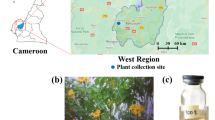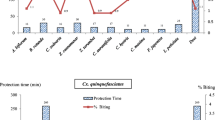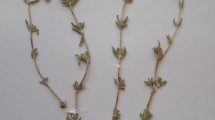Abstract
Since ancient times, plant products were used in various aspects. However, their use against pests decreased when chemical products became developed. Recently, concerns increased with respect to public health and environmental security requiring detection of natural products that may be used against insect pests. In this study, 41 plant extracts and 11 oil mixtures were evaluated against the yellow fever mosquito, Aedes aegypti (Linnaeus), the malaria vector, Anopheles stephensi (Liston), and the filariasis and encephalitis vector, Culex quinquefasciatus (Say) (Diptera: Culicidae) using the skin of human volunteers to find out the protection time and repellency. The five most effective oils were those of Litsea (Litsea cubeba), Cajeput (Melaleuca leucadendron), Niaouli (Melaleuca quinquenervia), Violet (Viola odorata), and Catnip (Nepeta cataria), which induced a protection time of 8 h at the maximum and a 100% repellency against all three species. This effect needs, however, a peculiar formulation to fix them on the human skin.




Similar content being viewed by others
References
Ansari MA, Vasudevan P, Tandon M, Razdan RK (2000) Larvicidal and mosquito repellent action of peppermint (Mentha piperita) oil. Bioresour Technol 71:267–271
Barnard D (1999) Repellency of essential oils to mosquitoes (Diptera: Culicidae). J Med Entomol 36:625–629
Bläske V, Hertel H, Forschler BT (2003) Repellent effects of isoborneol on subterranean termites (Isoptera: Rhinotermitidae) in soils different composition. J Econ Entomol 96:1267–1274
Chavasse DC, Yap HH (1997) Chemical methods for the control of vectors and pests of public health importance. Geneva, Switzerland, WHO/CTD/WHOPES/97.2.129 p
Curtis CF, Hill N (1988) Comparison of methods of repelling mosquitoes. Entomol Exp Appl 49:175–179
Das NG, Nath DR, Baruah I, Talukdar PK, Das SG (1999) Field evaluation of herbal mosquito repellents. J Commun Dis 31(4):241–245
Debboun M, Strickman D, Klein TA, Glass JA, Wylie E, Laughinghouse A, Wirtz RA, Gupta RK (1999) Laboratory evaluation of AI3-37220, AI3-35765, CIC-4, and DEET repellents against three species of mosquitoes. J Am Mosq Control Assoc 15:342–347
Dover C (1930) An improved citronella mosquito deterrent. Indian J Med Res 17:961
Eisner T (1964) Catnip: its raison d’etre. Science 146:1318–1320
Eisner T, Eisner M, Aneshansley DJ, WuC, Meinwald J (2000) Chemical defense of the mint plant, Teucrium marum (Labiatae). Chemoecology 10:211–216
Freeborn SB (1928) Observations on the control of Sierran Aedes (Culicidae: Diptera). Pan-Pac Entomol 4:177–181
Gupta RK, Rutledge LC (1989) Laboratory evaluation of controlled-release repellent formulations on human volunteers under three climatic regimens. J Am Mosq Control Assoc 5:52–55
Jantan I, Zaki ZM (1998) Development of environment-friendly insect repellents from the leaf oils of selected Malaysian plants. ASEAN Review of Biodiversity and Environmental Conservation, May 1998
Jilani G, Saxena CR, Rueda BP (1988) Repellent and growth-inhibiting effects of turmeric oil, sweetflag oil, neem oil, and margosan-O on red flour beetle (Coleoptera: Tenebrionidae). J Econ Entomol 81:1226–1230
Moore BP (1974) In: Birch MC (ed) Pheromones. North Holland/Am. Elsevier, Amsterdam, New York, p 250
Palsson K, Jaenson TGT (1999) Plant products used as mosquito repellents in Guinea Bissau, West Africa. Acta Tropica 72:39–52
Penfold AR, Morrison FR (1952) Some Australian essential oils in insecticides and repellents. Soap,Perfum Cosmet 52:933–934
Perttunen V (1957) Reactions of two bark species, Hylurgops palliatus Gyll. and Hylastes arer Payk. To the terpene α-pinene. Suomen Hyonteistieteellinen Aikakauskirja 23:101–110
Peterson CJ, Ems-Wilson J (2003) Catnip essential oil as a barrier to subterranean termites (Isoptera: Rhinotermitidae) in the laboratory. J Econ Entomol 96:1275–1282
Peterson C, Coats J (2001) Insect repellents—past, present and future. Pesticide outlook—August 2001
Schreck CE, McGovern TP (1989) Repellents and other personal protection strategies against Aedes albopictus. J Am Mosq Control Assoc 5:247–252
Takikawa H, Yamazaki Y, Mori K (1998) Synthesis and absolute configuration of rotundial, a mosquito repellent from the leaves of Vitex rotundiforia. Eur J Org Chem 229–232
Tawatsin A, Wratten SD, Scott RR, Thavara U, Techadamrongsin Y (2001) Repellency of volatile oils from plants against three mosquito vectors. J Vector Ecol 26:7–82
Thavara U, Tawatsin A, Chompoosri J, Suwonkerd W, Chansang U, Asavadachanukorn P (2001) Laboratory and field evaluations of the insect repellent 3535 (ethyl-butyl-acetyl-aminopropionate) and DEET against mosquito vectors in Thailand. J Am Mosq Control Assoc 17:190–195
Ulubelen A, Mericli AH, Mericli F, Kilincer N, Ferizli AG (2001) Insect repellent activity of diterpenoid alkaloids. Phytother Res 15:170–171
WHO (1996) Report of the who informal consultation on the evaluation and testing of insecticides CTD/WHOPES/IC/96.1 Geneva: Control of Tropical Diseases, World Health Organization
Yap HH, Jahangir K, Zairi J (2000) Field efficacy of four insect repellent products against vector mosquitoes in a tropical environment. J Am Mosq Control Assoc 16:241–244
Zhu BCR, Henderson G, Chen F, Fei H, Laine RA (2001) Evaluation of vetiver oil and seven insect-active essential oils against the Formosan subterranean termite. J Chem Ecol 27:1617–1625
Author information
Authors and Affiliations
Corresponding author
Rights and permissions
About this article
Cite this article
Amer, A., Mehlhorn, H. Repellency effect of forty-one essential oils against Aedes, Anopheles, and Culex mosquitoes. Parasitol Res 99, 478–490 (2006). https://doi.org/10.1007/s00436-006-0184-1
Received:
Accepted:
Published:
Issue Date:
DOI: https://doi.org/10.1007/s00436-006-0184-1




